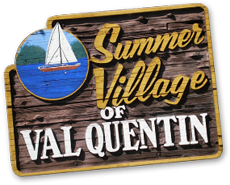The Region
The Summer Village of Val Quentin is located approximately 75 km northwest of Edmonton, Alberta on the southeast shores of Lac Ste. Anne, Alberta. It borders the village of Alberta Beach to the east and Lac Ste. Anne County to the west and south. It was officially established on June 1, 1960. The Summer Village covers 22 hectares and had a permanent population of 157 living in 104 dwellings in the 2013 Federal Census.
The Summer Villages of Val Quentin, Ross Haven, Sunset Point and West Cove all border Lac Ste. Anne. Lac Ste. Anne is a large lake in central Alberta, Canada. It is located in Lac Ste. Anne County, along Highway 43, 75 km west of Edmonton.
The lake has a total area of 54.5 km2, a maximum depth of 9 m, and an average depth of 4.8 m.Lac Ste. Anne lies at an elevation of 730
The Atlas of Alberta Lakes is an excellent resource to learn more about the lake, its history and its current use.
Environmentally, particularly as it relates to the lake itself, most (but not all) cottage owners and users of Lac Ste. Anne
Alberta Beach
Several miles east, Lac Ste. Anne was the hostess of more history. In 1912, the Alberta Northern Rail (ANR) built the railroad to what is now Alberta Beach. It brought its employees out for company picnics and holidays. By 1920, they had incorporated the area as a summer village, built a dance pavilion, a large wooden pier, and several cabins. Other companies such as Marshall Wells and Woodward’s then began to bring their employees out for the same relaxing and beautiful atmosphere.
The area was in such demand that the Moonlight Express was started. ANR picked passengers up in Edmonton on Saturday mornings, took them to Alberta Beach, and then returned them on Sunday night to Edmonton.
Soon people began purchasing and building their own cabins, and small businesses. In 1999, the Summer Village of Alberta Beach became a village boasting 884 year round residents, and swelling to over 3000 people during long weekends. A hotel and many small businesses prosper within the village. Alberta Beach has developed in many ways while still preserving the reason for its original popularity. The
Hamlet of Gunn
In the 1900s, the Hamlet of Gunn was also developing as a major trade center, consisting mainly of Métis and Indian people. There were two flour mills, a blacksmith shop, a hotel, and several stores and trading posts that nestled beside the train station. In the 1930s, an army training center was built where the Gunn Housing Center now operates. Prosperity reigned until the army left and the Canadian National Railway (CNR) removed its rail station. With it, many of the residents and businesses also left. Today all that remains is a combination store, laundromat, restaurant, car wash and post office, a community hall and a University of Alberta observation and research station, as well as the Gunn Housing and Senior’s Center.
Castle Island
In the 1890s, a French viscount by the name of Charles de Gaze began building a castle on the small island located on the northeast shores of Lac Ste. Anne, which he named Constance Island, in
Approximately twenty years later, a Mr. Shorty purchased the island. He demolished the castle and transported several cabins to Constance Island. During prohibition, it was an excellent spot for parties and fun. Years later he built a causeway which provided better access to the island.
Darwell
In 1912, a rail station was also responsible for creating another community: Darwell, located between Lac Ste. Anne and Isle Lake. The naming of this station caused many debates with no
Darwell Station became known throughout Alberta as “Hobo Stop” because of a ranch which never turned away anyone asking for shelter. Many men who were out of work rode the rail to Darwell to get food and lodging in exchange for work. As the story goes, many a man wanted by the law also found refuge and the North-West Mounted Police made many trips to the Hobo Ranch. Today Darwell boasts a store, garage and school. The old ranch has long disappeared, but the hospitality of this hamlet still exists today
Over the past few years, there has been an increase in the number of residents permanently residing in the Val Quentin. There is a desire to see expansion and growth, yet maintain the current character and aesthetics of the summer village. Our Land Use Bylaw helps to accomplish this goal.
|
Val Quentin Statistics Membership in Regional Service Commissions |
|
|
Highway 43 East Waste Commission Tri-Village Regional Sewage Services Commission West Inter-Lake District Regional Water Services Commission |
|
|
General Statistics – Stats Canada (2021) |
|
|
Total Full-time Positions |
1 |
|
Population -Full Time |
158 |
|
Length of all Roads Maintained (km) |
5 |
|
Wastewater Mains Length (km) |
4 |
|
Number of Residences |
160 |
